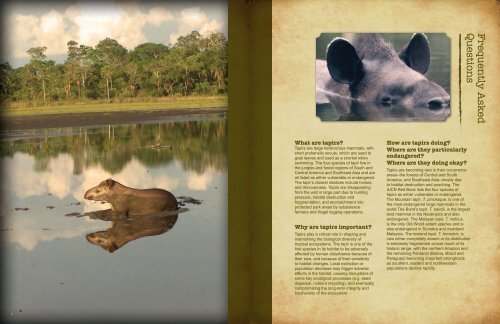About Tapirs - Tapir Specialist Group
About Tapirs - Tapir Specialist Group
About Tapirs - Tapir Specialist Group
Create successful ePaper yourself
Turn your PDF publications into a flip-book with our unique Google optimized e-Paper software.
What are tapirs?<br />
<strong><strong>Tapir</strong>s</strong> are large herbivorous mammals, with<br />
short prehensile snouts, which are used to<br />
grab leaves and used as a snorkel when<br />
swimming. The four species of tapir live in<br />
the jungles and forest regions of South and<br />
Central America and Southeast Asia and are<br />
all listed as either vulnerable or endangered.<br />
The tapir’s closest relatives include horses<br />
and rhinoceroses. <strong><strong>Tapir</strong>s</strong> are disappearing<br />
from the wild in large part due to hunting<br />
pressure, habitat destruction and<br />
fragmentation, and encroachment into<br />
protected park areas by subsistence<br />
farmers and illegal logging operations.<br />
Why are tapirs important?<br />
<strong><strong>Tapir</strong>s</strong> play a critical role in shaping and<br />
maintaining the biological diversity of<br />
tropical ecosystems. The tapir is one of the<br />
first species in its habitat to be adversely<br />
affected by human disturbance because of<br />
their size, and because of their sensitivity<br />
to habitat changes. Local extinction or<br />
population decrease may trigger adverse<br />
effects in the habitat, causing disruptions of<br />
some key ecological processes (e.g. seed<br />
dispersal, nutrient recycling), and eventually<br />
compromising the long-term integrity and<br />
biodiversity of the ecosystem.<br />
How are tapirs doing?<br />
Where are they particularly<br />
endangered?<br />
Where are they doing okay?<br />
<strong><strong>Tapir</strong>s</strong> are becoming rare in their occurrence<br />
areas--the forests of Central and South<br />
America, and Southeast Asia--mostly due<br />
to habitat destruction and poaching. The<br />
IUCN Red Book lists the four species of<br />
tapirs as either vulnerable or endangered.<br />
The Mountain tapir, T. pinchaque, is one of<br />
the most endangered large mammals in the<br />
world.The Baird’s tapir, T. bairdii, is the largest<br />
land mammal in the Neotropics and also<br />
endangered. The Malayan tapir, T. indicus,<br />
is the only Old World extant species and is<br />
also endangered in Sumatra and mainland<br />
Malaysia. The lowland tapir, T. terrestris, is<br />
now either completely absent or its distribution<br />
is extremely fragmented across much of its<br />
historic range, with the northern Amazon and<br />
the remaining Pantanal (Bolivia, Brazil and<br />
Paraguay) becoming important strongholds<br />
as southern, eastern and northwestern<br />
populations decline rapidly.<br />
Frequently Asked<br />
Questions<br />
6 7










